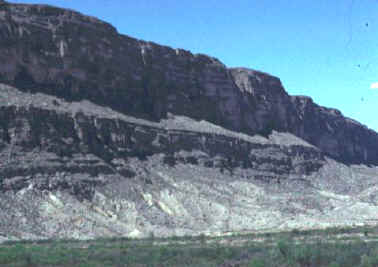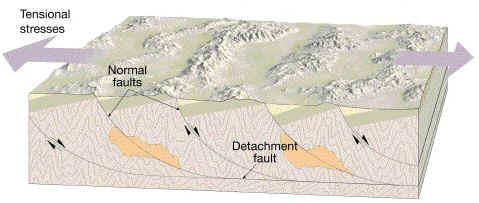
FAULT SCARP
3. Recognized on geologic maps by abrupt displacement of structures or rocks.
4. Characteristic of young mountain belts -> fault block mountains.
5. Basin and Range Province.
Landforms Developed on Folded/Tilted Strata
Underlying geologic
structure influences surface landforms in two ways:
1. determines outcrop pattern.
2. The relative elevation and/or slope of outcrops will vary, because different
rocks erode at different rates (depends on RELATIVE hardness of rock,
cementation strength (if sedimentary rock) and joint abundance). This is called
DIFFERENTIAL EROSION. Resistant
rock is left standing higher than less resistant rock, forming various types of
cliffs ("scarps") or ridges. The actual feature formed depends on the
dip of the strata. Mesas are wide flat-topped hills capped by a resistant
horizontal rock layer (a "caprock"); buttes are similar, narrower
hills; a cuesta is the combination of a dipslope and escarpment (or scarp); a
hogback is a fairly sharp ridge; a razorback is a very sharp ridge (dip of the
rock layer determines which will form).
Softer rock layers are eroded lower forming STRIKE VALLEYS - valleys parallel to strike direction - the strike stream is in a strike valley; the resistant beds form cuestas).
Outcrop Patterns and
Landforms On Geologic Maps.
Subsurface rock layers are usually exposed by downcutting streams and rivers.
Horizontal Strata
1. Outcrop pattern parallels valleys
2. Contacts between rock units parallel contours because strata are flat.
3. Uplifted horizontal strata form plateaus like the Colorado Plateau.
4. Vigorous downcutting during/after uplift forms canyons like the Grand Canyon.
5. Resistant strata form steep cliffs; softer rock erodes to gentler slopes.
6. Prolonged erosion isolates blocks of rock, forming mesas, buttes and
pinnacles.
Tilted Strata
1. Outcrops are roughly
parallel bands.
2. Law of V's - low dip angle -> larger V.
3. Older beds dip towards younger beds (except in overturned folds, which are
uncommon).
4. Differential erosion forms ridges, dipslopes, escarpments, cuestas, strike
valleys.
4. Cuestas, hogbacks or razorbacks are formed by resistant beds; strike valleys
formed by softer beds. (Review Lab 2).
Domes
1. Outcrops are concentric belts.
2. Oldest rocks are in the center.
3. Law of V's -> beds dip away from center.
4. Resistant beds form inward-facing scarps.
5. Core of dome determines relief; if resistant -> central upland; if soft
-> central lowland.
Basins
1. Outcrops are concentric belts.
2. Youngest rocks are in the center.
3. Law of V's -> beds dip towards center.
4. Resistant beds form outward-facing scarps.
Folds
1. Erosion of plunging folds (most plunge) -> zigzag pattern.
2. Anticlines V down plunge; oldest beds at center. Law of V's -> beds dip
away from center; resistant rocks -> inward-facing scarps.
3. Synclines V up plunge; youngest beds at center; Law of V's ->
beds dip towards center; resistant rocks -> outward-facing scarps.
4. Since most folds form at depth, fold outcrop patterns are typical in eroded
ancient mountain belts such as the Appalachians.
Landforms Developed On
Faulted Strata
1. Form sharp linear boundaries of uplands or valleys.
2. Displacement -> fault scarps.

FAULT SCARP
3. Recognized on geologic maps by abrupt displacement of structures or rocks.
4. Characteristic of young mountain belts -> fault block mountains.
5. Basin and Range Province.

BASIN & RANGE DEVELOPMENT
Caused by crustal stretching due to heat flow from subduction. Tilting of normal faults resulted in fault-angle depressions (tilted fault blocks).
Surficial Deposits
1. Unconsolidated recent sediments e.g. river sands, glacial deposits, landslide
deposits.
2. Usually form a thin cover on underlying bedrock.
3. Usually associated with process e.g. river deposits in present river valleys;
landslide debris at base of cliff etc.
Influence of Geologic Structure On Drainage Patterns
1. Streams that develop
on "original surface" (e.g. emergent coastal plain) follow the
regional slope = CONSEQUENT STREAMS.
2. Continued erosion -> strike valleys occupied by SUBSEQUENT STREAMS.
3. Tributaries to subsequent streams that follow regional slope = RESEQUENT
STREAMS (REnewed conSEQUENT); tributary streams that flow in the opposite
direction to consequent streams = OBSEQUENT STREAMS (Oppsite to conSEQUENT).